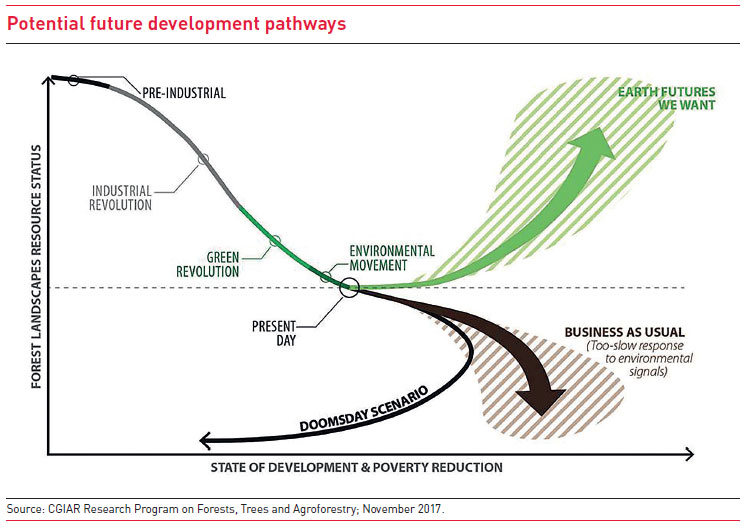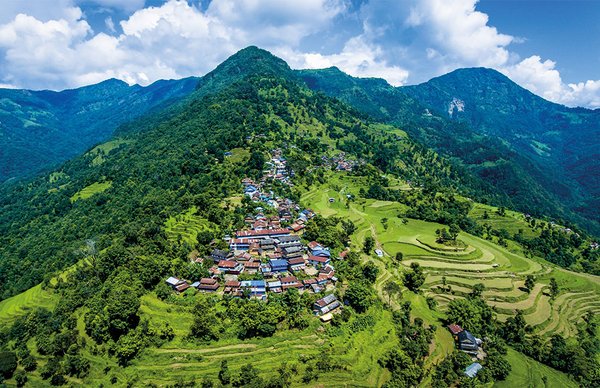Give forests the attention they deserve
The world is covered by approximately four billion hectares of forests, of which 93 per cent are natural forest and seven per cent plantations. Among the former, 33 per cent can be considered as intact (“primary”) forests and 60 per cent are naturally regenerated forests, i.e. forests under some form of management. Primary forests are of tremendous value for biodiversity, harbouring more than 80 per cent of the terrestrial biodiversity and ecosystem services. Losing them would have unimaginable consequences.
An estimated 1.6 billion people depend on forests and trees outside forest resources for their livelihoods. More than 800 million people (30 per cent of the global rural population) live on 9.5 million square kilometres of agricultural lands (45 per cent of the total terrestrial area) with more than 10 per cent tree cover, 180 million on the 3.5 million square kilometres of agricultural lands with more than 30 per cent tree cover, and about 350 million within or near 40 million square kilometres of dense forests. The estimated value of ecosystem services stemming from forests, trees and savannahs represents more than 76 trillion US dollars (USD).
A wide range of products and services
According to World Bank figures, the international timber trade generates up to 150 billion USD a year, and the real value of local and national timber trade – sawnwood, panels, roundwood, fuelwood – is likely as large. Income derived from the sale of non-timber forest and farm products, such as bamboo, nuts, fruits, honey and bushmeat, adds another 50 billion USD.
Perennial tree crops and tropical forest products play a vital role in the livelihoods of hundreds of millions of households; they are also a primary source of export earnings and foreign exchange, representing hundreds of billions of USD for many countries, with vital spillovers for local development. Tree crop value chains produce important globally traded commodities including cocoa, coffee, coconut, rubber and oil palm that form the basis of smallholder livelihoods. Cocoa and coffee alone cover 20 million hectares and are the mainstay of over 30 million smallholder households. Recent global assessments suggest that up to 28 per cent of household income is derived from forest resources for smallholders living at the forest margins. More than 80 per cent of rural people in the developing world still depend on fuelwood for cooking as well as warmth.
For the first time in history, more than 50 per cent of the world’s population now live in towns and cities. By 2050, this number is expected to increase to 66 per cent. The rapid expansion of cities has highly damaging effects on forests and “green” areas: increased pollution, decreased availability of food and resources, as well as increased poverty and frequency of extreme climatic events. Urban forests and trees play an important role in increasing urban biodiversity, providing plants and animals with a favourable habitat, food and protection. Strategic placement of trees in cities can help to cool the air between two and eight degrees Celsius. Trees around buildings can reduce the need for air conditioning by 30 per cent and considerably reduce heating bills. Trees are excellently suited to absorb pollutants and filter fine particulates out of the air.
Forests and cultures are intricately linked. The recreational value of forests as places of and sources for spiritual comfort is now widely recognised. Growing numbers of people visit forests each year, so much so that some suffer from severe overuse. Living in close proximity of urban green spaces and having access to them can improve physical and mental health, for example by lowering high blood pressure and reducing stress. This, in turn, contributes to the well-being of urban communities. The Japanese even invented a word for using forests for such purposes: “shinrin-yoku” (“forest bathing”).
A green infrastructure for sustainable development
We have made remarkable progress in terms of wealth and health, but there are still 900 million people going hungry, and most of our development has been at the expense of natural resources. Forests and trees have been particularly hit, destroyed for agriculture or degraded by suboptimal management. Around 12 million hectares of land are lost each year to degradation, harming the well-being of at least 3.2 billion people and costing more than 10 per cent (6.3 trillion USD) of annual global GDP in lost ecosystem services!
Continuing this trend threatens the future of agriculture, and humanity itself. Beyond the myriad of goods produced, forests and trees are also fundamental to sustaining food systems, ecosystem services and mitigating or adapting to climate change. Progress towards achieving the SDGs and the recently reached Paris agreement on climate change requires the world to shift its historical development trajectory away from a ‘doomsday scenario’ or business as usual environmental degradation where development continues at the expense of the environment (also see Figure).

Managed well, forests and trees offer a unique opportunity to contribute to all the 17 SDGs because of their spatial extent, the range of goods or services they produce or maintain, and the number of people they provide such goods and services to.
The significance of landscape approaches
“Landscape approaches” are now used by many major organisations and agencies specialised in food production and poverty alleviation thanks to the recognition that ecosystems and humans are integrated parts of complex social-ecological systems. These approaches are inherently complex and dynamic, as opposed to approaches with clearly-bounded spatial entities. People, in various forms of social organisations, shape the landscape and its natural resource base while their options are essentially bound by both the potential of the land and these resources as well as the prevailing natural resource governance system. Changing the trajectory of a landscape implies a change in the behaviour of the key actors within that landscape and thus requires the identification of successful leverage points and negotiated approaches.
Our ideal approach for forests could be summarised in three points:
Conservation: we must conserve the remnant “primary” forests and critical ecosystems (peatlands, mangroves, tropical mountain cloud forests …); such land should not be newly allocated for industrial uses or conversion to agriculture.
Sustainable use: we must sustainably use the large area of “naturally managed forests” for the provision of goods, jobs and services to humankind; preferably we should foster community-based management and make sure that local communities reap real benefits from their forests beyond those gained by the global community. We must increase the area of plantations, making sure they are established based on best agro-ecological and social practices, as they constitute the most parsimonious use of land to produce the required wood and wood-based material to shift towards a bioeconomy.
Restoration: We must restore the huge areas of degraded forest lands but pursue this as an economic enterprise that creates jobs and wealth while restoring ecosystem services and diversity.
Forests are our most important terrestrial natural capital and are excessively under-valued and under-appreciated. It is vital to establish a science-based understanding on the state of the world’s forests, including threats and the opportunities they offer to transition from a fossil economy towards a circular bioeconomy. Forests require a long-term and holistic approach which integrates climate change mitigation and adaptation, biodiversity and their role in decarbonising our economy. This approach requires us to overcome the past short-sighted and polarised debate between conservation and production. Biodiversity and the bioeconomy are the two sides of the same coin: sustainable development.
Robert Nasi is Director-General of the Center for International Forestry Research (CIFOR) and Managing-Director of CIFOR-ICRAF, formed when the Center for International Forestry Research (CIFOR) and World Agroforestry (ICRAF) merged last January.
Contact: R.Nasi@cgiar.org
References and further reading
Angelsen A. et al. 2014. Environmental income and rural livelihoods: A global-comparative analysis. World Development 64(S1): S12–S28.
Chao S. 2012. Forest Peoples: Numbers Across the World. Moreton-in-Marsh, UK: Forest Peoples Programme.
Díaz, S. et al. 2019. Summary for policymakers of the global assessment report on biodiversity and ecosystem services of the Intergovernmental Science-Policy Platform on Biodiversity and Ecosystem Services.
Ferreira FHG et al. 2015. A global count of the extreme poor in 2012: data issues, methodology and initial results. Policy Research working paper; no. WPS 7432. Washington, DC: World Bank Group.
Food and Agriculture Organization. 2015. The state of food insecurity in the world. Rome: FAO.
Food and Agriculture Organization. 2015. Global Forest Resources Assessment 2015
Gibbs HK et al. 2010. Tropical forests were the primary sources of new agricultural land in the 1980s and 1990s. PNAS 107(38): 16732–7.
Isbell F et al. 2015. The biodiversity-dependent ecosystem service debt. Ecology Letters 18(2):119–34.
Laurance WF et al. 2014. Agricultural expansion and its impacts on tropical nature. Trends in Ecology and Evolution 29(2):107–16.
Maxwell, S.L. et al. 2019. Degradation and forgone removals increase the carbon impact of intact forest loss by 626 %. Science advances, 5(10), p.eaax2546.
Sayer, Jeffrey, et al. "Ten principles for a landscape approach to reconciling agriculture, conservation, and other competing land uses." Proceedings of the national academy of sciences 110.21 (2013): 8349-8356.
Schramski et al. 2015. Human domination of the biosphere: Rapid discharge of the earth-space battery foretells the future of humankind. PNAS doi: 10.1073/pnas.1508353112.
Seppala R et al. 2009. Adaptation of forests and people to climate change. A global assessment report. IUFRO World Series Vol. 22. Vienna: IUFRO.
Steffen et al. 2015. Planetary boundaries: Guiding human development on a changing planet. Science 347(6223).
Sutton, P. C. et al. 2016. The ecological economics of land degradation: Impacts on ecosystem service values. Ecological Economics, 129, 182-192.
Vira B et al. (eds). 2015. Forests, Trees and Landscapes for Food Security and Nutrition. A Global Assessment Report. IUFRO World Series Vol. 33. Vienna: International Union of Forest Research Organizations (IUFRO).
Zomer RJ et al. 2009. Trees on farm: analysis of global extent and geographical patterns of agroforestry. ICRAF Working Paper No 89. Nairobi: World Agroforestry Centre.





Add a comment
Be the First to Comment